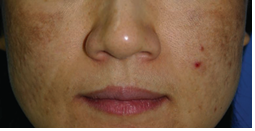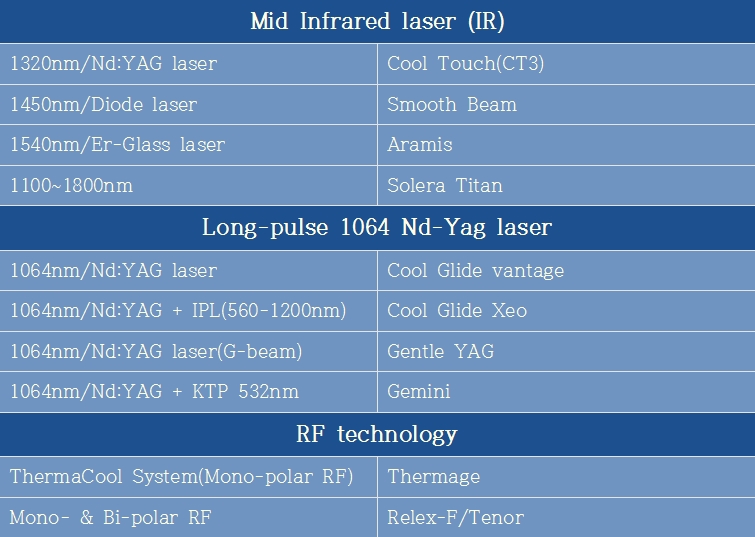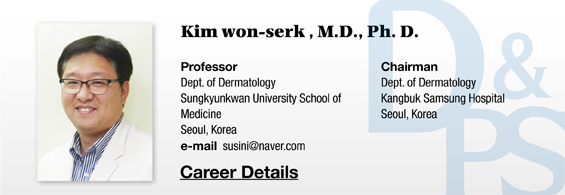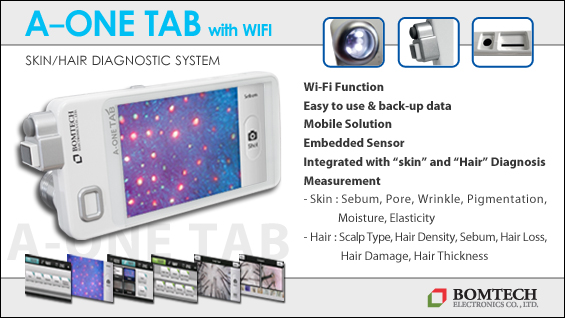With the development various lasers, they are becoming more and more widely used for scar treatment. Among various types of scars typically treated with laser, atrophic scar such as acne scar was initially treated with CO2 or Erbium YAG laser for ablation, and then the trend has moved to noninvasive lasers, so called non-ablative rejuvenation laser(NAR)and fractional laser. Laser for hypertrophic scar and keloid has not been confirmed with accurate therapeutic effect, but pulsed dye laser is applied as a standard or recent intense pulse light and fractional laser as new options.
Laser for Atrophic Scar
Atrophic scar develops typically when the skin collagen is damaged after inflammatory skin disease, such as acne, or trauma. Variousconventional treatments, including simple excision, mechanical microdermabrasion and augmentation with filling agents, have been tried for atrophic scar. Surgical excision is the most effective method within a short period of time, but it accompanies the risk of side effect and is difficult to apply to a small and mild atrophic scar. Fillers can also produce immediate effect within a short period of time, but it is not appropriate for fine correction of scar and permanent effect. Laser is preferred for correction of relatively small and shallow scars and produces permanent effect, but the need for repetitive procedure, therefore longer duration of treatment, in most cases is a disadvantage of laser treatment. Below are the lasers that are commonly used for the treatment of atrophic scar.
[Advertisement] A-One Tab with Wi-Fi(Skin/Hair Diagnostic System) – Manufacturer: BOMTECH(www.bomtech.net)
1. Ablative Laser
Ablative laser removes the epidermis and dermis, inducing a new wound healing process and increases collagen in the process. The most commonly used are CO2
laser and Er:YAG laser, both of which produces wavelengths that can be easily absorbed by water, thereby removing the skin as if peeled from the outer layer. One difference between the two lasers is the absorption rate by water. Er:YAG laser has high absorption rate by water, inducing less heat injury to the surrounding tissues, while CO2 laser has been suggested to cause more heat injury but stimulates more collagen synthesis and skin contraction.

Absorption rate of ablative lasers by water
Despite the dramatic effect with single procedure, ablative lasers are less frequently used now due to not infrequent occurrence of side effect. It is still used, however, for severe acne scar not responsive to other laser treatments.

Atrophic scar improved after treatment with ablative laser

A common side effect of ablative laser: Post-inflammatory hyperpigmentation
2. NAR (Non-ablative Remodeling) Laser
NAR refer to lasers and high-frequency devices that were developed as alternatives to overcome long duration of treatment, difficulty of wound management and coloration or redness after treatment with ablative lasers. In short, they minimize heat injury to the epidermis by cooling system and produces wavelengths that can be absorbed properly by water inside the dermis, raising the temperature of the dermis to about 45-60 degrees. At this temperature, the laser inflicts reversible injury, thereby stimulating fibroblast and increasing collagen synthesis.

Fig 4. Representative NAR devices
NAR devices are safe, associated with few side effects, and painless during the procedure, making it promising and popular early in the development. With the development of Fractional laser to overcome delayed effect and longer duration of treatment of NAR devices, their demand has been decreasing.
3. Fractional Laser
Fractional laser stimulates the skin by producing minute, narrow and deep thermal necrotic colums horizontally to the skin tissue. It is placed between ablative laser and NAR laser in terms of effect and side effects. More specifically, the effect is relatively good and regeneration time is short, making it a representative laser for the treatment of atrophic scar. Fractional laser uses various wavelengths, mostly 1320, 1440, 1540 and 1550nm which are used for the previous NAR lasers. There is another laser developed by integrating the existing ablative CO2 laser or Er:YAG laser with fractional technology, which is called ablative fractional laser. Despite being more invasive, there have been few reports comparing the effect and side effects with common non-ablative fractional laser.
- To be continued-
▶ Previous Artlcle : #4. Drugs and Topical Agents for Hypertrophic Scar and Keloid II
▶ Next Artlcle : #6. Laser for Scar Treatment Ⅱ





















